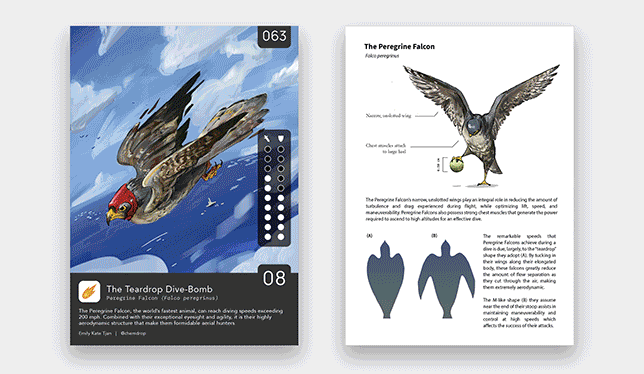What do a pistol shrimp, a blue dragon sea slug and a panther chameleon have in common?
Each one is now the star of its own “SciCard,” a set of science-focused trading cards created by a team of students in the University of Toronto’s master of science in biomedical communications (BMC) program.
Inspired by the Pokémon collectible cards they grew up with, BMC students Shehryar Saharan and Xingyu (Michie) Wu devised the unique science-art project during the first wave of last year’s COVID-19 lockdown. It was a way to connect with peers and faculty, as well as a chance to take what they were learning in their program in an even more creative direction.

“I’ve always loved science, and I’ve always loved art, and I’ve always hoped to find a career that was a mix of both,” says Ms. Wu. When she discovered BMC, it was a proverbial lightbulb moment—though she almost literally stumbled into it in the health sciences complex at the U of T’s Mississauga campus, while she was studying for a bachelor of science.
“There was just this one floor dedicated to the BMC program, and you walk in and see this incredible scientific artwork all over the walls,” she said. “That’s how I discovered it, and I felt, ‘Oh wow, this is what I need to do.’”
The idea was simple: Ms. Wu, Mr. Saharan and seven other students each chose a different part of the natural world (an animal, plant, even a molecule) and decided what style they would use to illustrate it. Like Pokémon cards, which features statistics on each Pokémon, including their unique abilities, the SciCards highlight an extraordinary trait for each creature, explaining it in more detail on the reverse.
Mr. Saharan chose a panther chameleon, which can change colour by adjusting the spacing of reflective crystals in its skin. He drew the chameleon in carbon dust, then inverted the image to create a night-vision appearance.
Ms. Wu illustrated her sea slug, meanwhile, in the style of official Pokémon art, making for a stylized cartoon depiction of the animal in its murky underwater habitat.
And just as with Pokémon, each SciCard assigns a certain number of hit points to the creature. Saharan’s chameleon earned a 48. Ms. Wu’s Blue Dragon Sea Slug came in at 58, thanks to its special ability: “It has poisoned fingers,” she said, “and if you touch it, it actually injects you with venom.”
Seven other students contributed cards as well, ranging from the pistol shrimp (which can shoot high-velocity bubbles) to the Southern Cassowary (a flightless bird with dagger-like claws and a dangerous kick).
Ms. Wu and Mr. Saharan plan to include the cards in welcome packages for incoming BMC students and hope they inspire an annual tradition.
There could be more practical uses as well. “We see something like this being really useful in high school or even elementary school classes,” said Mr. Saharan. “It would be really cool to trade them, turn them into a game – some interactive way to introduce these concepts to students just beginning to learn about the animal kingdom.”
Great work! I would like to get these cards for my son.
Hi Kalpita: Contact [email protected].